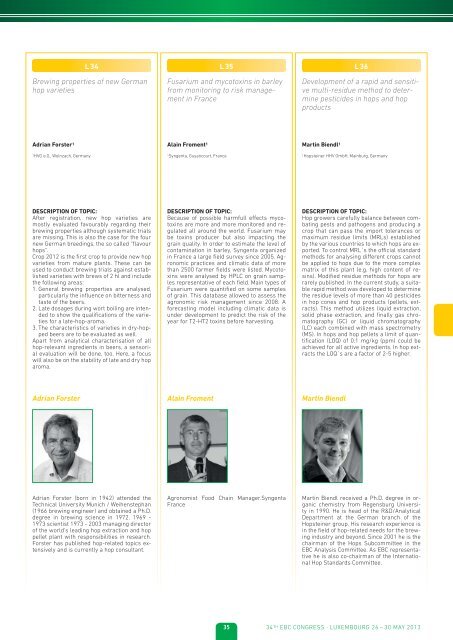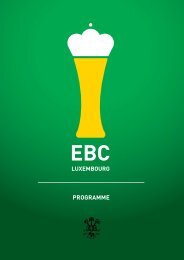please click here for download. - the 34th European Brewery ...
please click here for download. - the 34th European Brewery ...
please click here for download. - the 34th European Brewery ...
Create successful ePaper yourself
Turn your PDF publications into a flip-book with our unique Google optimized e-Paper software.
L 34<br />
Brewing properties of new German<br />
hop varieties<br />
L 35<br />
Fusarium and mycotoxins in barley<br />
from monitoring to risk management<br />
in France<br />
L 36<br />
Development of a rapid and sensitive<br />
multi-residue method to determine<br />
pesticides in hops and hop<br />
products<br />
Adrian Forster 1<br />
1HVG e.G., Wolnzach, Germany<br />
Alain Froment 1<br />
1Syngenta, Guyancourt, France<br />
Martin Biendl 1<br />
1Hopsteiner HHV GmbH, Mainburg, Germany<br />
DESCRIPTION OF TOPIC:<br />
After registration, new hop varieties are<br />
mostly evaluated favourably regarding <strong>the</strong>ir<br />
brewing properties although systematic trials<br />
are missing. This is also <strong>the</strong> case <strong>for</strong> <strong>the</strong> four<br />
new German breedings, <strong>the</strong> so called “flavour<br />
hops”.<br />
Crop 2012 is <strong>the</strong> first crop to provide new hop<br />
varieties from mature plants. These can be<br />
used to conduct brewing trials against established<br />
varieties with brews of 2 hl and include<br />
<strong>the</strong> following areas:<br />
1. General brewing properties are analysed,<br />
particularly <strong>the</strong> influence on bitterness and<br />
taste of <strong>the</strong> beers.<br />
2. Late dosages during wort boiling are intended<br />
to show <strong>the</strong> qualifications of <strong>the</strong> varieties<br />
<strong>for</strong> a late-hop-aroma.<br />
3. The characteristics of varieties in dry-hopped<br />
beers are to be evaluated as well.<br />
Apart from analytical characterisation of all<br />
hop-relevant ingredients in beers, a sensorial<br />
evaluation will be done, too. Here, a focus<br />
will also be on <strong>the</strong> stability of late and dry hop<br />
aroma.<br />
DESCRIPTION OF TOPIC:<br />
Because of possible harmfull effects mycotoxins<br />
are more and more monitored and regulated<br />
all around <strong>the</strong> world. Fusarium may<br />
be toxins producer but also impacting <strong>the</strong><br />
grain quality. In order to estimate <strong>the</strong> level of<br />
contamination in barley, Syngenta organized<br />
in France a large field survey since 2005. Agronomic<br />
practices and climatic data of more<br />
than 2500 farmer fields were listed. Mycotoxins<br />
were analysed by HPLC on grain samples<br />
representative of each field. Main types of<br />
Fusarium were quantified on some samples<br />
of grain. This database allowed to assess <strong>the</strong><br />
agronomic risk management since 2008. A<br />
<strong>for</strong>ecasting model including climatic data is<br />
under development to predict <strong>the</strong> risk of <strong>the</strong><br />
year <strong>for</strong> T2-HT2 toxins be<strong>for</strong>e harvesting.<br />
DESCRIPTION OF TOPIC:<br />
Hop growers carefully balance between combating<br />
pests and pathogens and producing a<br />
crop that can pass <strong>the</strong> import tolerances or<br />
maximum residue limits (MRLs) established<br />
by <strong>the</strong> various countries to which hops are exported.<br />
To control MRL´s <strong>the</strong> official standard<br />
methods <strong>for</strong> analysing different crops cannot<br />
be applied to hops due to <strong>the</strong> more complex<br />
matrix of this plant (e.g. high content of resins).<br />
Modified residue methods <strong>for</strong> hops are<br />
rarely published. In <strong>the</strong> current study, a suitable<br />
rapid method was developed to determine<br />
<strong>the</strong> residue levels of more than 40 pesticides<br />
in hop cones and hop products (pellets, extracts).<br />
This method utilizes liquid extraction,<br />
solid phase extraction, and finally gas chromatography<br />
(GC) or liquid chromatography<br />
(LC) each combined with mass spectrometry<br />
(MS). In hops and hop pellets a limit of quantification<br />
(LOQ) of 0.1 mg/kg (ppm) could be<br />
achieved <strong>for</strong> all active ingredients. In hop extracts<br />
<strong>the</strong> LOQ´s are a factor of 2-5 higher.<br />
Adrian Forster<br />
Alain Froment<br />
Martin Biendl<br />
Adrian Forster (born in 1942) attended <strong>the</strong><br />
Technical University Munich / Weihenstephan<br />
(1966 brewing engineer) and obtained a Ph.D.<br />
degree in brewing science in 1972. 1969 -<br />
1973 scientist 1973 - 2003 managing director<br />
of <strong>the</strong> world‘s leading hop extraction and hop<br />
pellet plant with responsibilities in research.<br />
Forster has published hop-related topics extensively<br />
and is currently a hop consultant.<br />
Agronomist Food Chain Manager.Syngenta<br />
France<br />
Martin Biendl received a Ph.D. degree in organic<br />
chemistry from Regensburg University<br />
in 1990. He is head of <strong>the</strong> R&D/Analytical<br />
Department at <strong>the</strong> German branch of <strong>the</strong><br />
Hopsteiner group. His research experience is<br />
in <strong>the</strong> field of hop-related needs <strong>for</strong> <strong>the</strong> brewing<br />
industry and beyond. Since 2001 he is <strong>the</strong><br />
chairman of <strong>the</strong> Hops Subcommittee in <strong>the</strong><br />
EBC Analysis Committee. As EBC representative<br />
he is also co-chairman of <strong>the</strong> International<br />
Hop Standards Committee.<br />
35 34 TH EBC CONGRESS · LUXEMBOURG 26 – 30 MAY 2013





